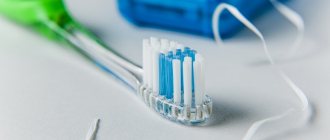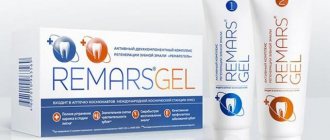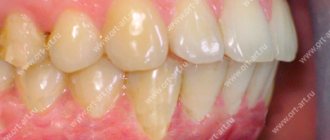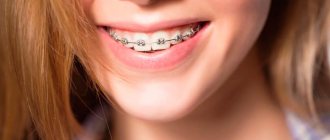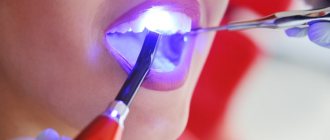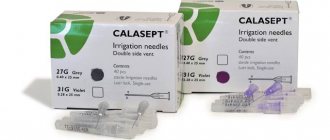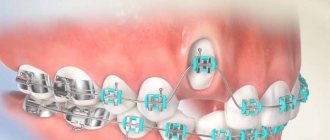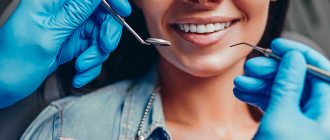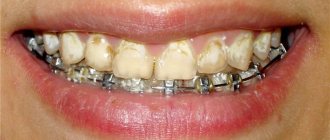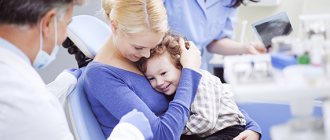Proper and daily oral care prevents the formation and accumulation of bacterial plaque, which is one of the main causes of caries and gum inflammation.
The main role in maintaining oral health is played by the correct use of high-quality oral hygiene products. It is important not only to select them with the help of a dentist, but also to strictly adhere to the regimen and technique of their use.
For daily brushing of teeth, in addition to a toothbrush and toothpaste, you need a small set of products:
- tongue cleaning brush;
— floss (interdental floss) for cleaning the side surfaces;
— superfloss (thread) for cleaning braces, bridges and wide spaces between teeth;
— mono-beam or small-beam brush for cleaning the gum line (gingival sulcus);
— brushes for cleaning interdental spaces.
The importance of oral hygiene
The health of our teeth and gums directly depends on proper oral hygiene. The importance of daily hygiene procedures is difficult to overestimate, but it is often easy to underestimate and pay with the loss of teeth even at a young age. So the statement of dentists that one of the most effective and at the same time simple ways to prevent dental diseases is proper and regular dental and oral hygiene in children and adults is more relevant than ever. We should not forget that hygiene procedures should not be limited to just brushing your teeth at home.
Preventive oral hygiene is a comprehensive measure that includes daily brushing of teeth and visiting a hygienist at least once a year. The fact is that in order to maintain teeth and gums in a healthy condition, it is necessary to promptly and efficiently remove dental plaque, as well as thick plaque on the tongue. Food debris and soft plaque can be removed with a toothbrush and toothpaste. But the removal of tartar (mineralized dental deposits) is carried out by a dentist using special means and instruments, for example, Air Flow. In this regard, comprehensive oral care implies individual and professional hygiene.
Professional teeth cleaning at the dentist
Professional teeth cleaning includes:
- Removal of hard dental plaque using an ultrasonic device or laser;
- Lightening of tooth enamel using modern gentle AIRFLOW technology;
- Polishing enamel using professional products;
- Treatment with fluoridating compounds that strengthen the enamel;
- Sealing of fissures using resins. This procedure is necessary to protect teeth from carious lesions.
It is important to remember that a healthy oral cavity is not only an aesthetically attractive appearance, but also a guarantee of the health of the body as a whole. Proper oral hygiene and regular visits to the dentist will help maintain the physiologically normal condition of teeth.
Individual oral hygiene
Individual oral hygiene is most effective if you follow certain rules on how to brush your teeth. As you know, there are many ways - each of them is correct and complete, it all depends only on our personal preferences. But it is still advisable to listen to the following recommendations from dentists:
- Always start brushing your teeth with the same row of teeth;
- adhere to a certain sequence of teeth cleaning so as not to miss any area;
- Carry out cleaning at the same pace in order to maintain the required duration of cleansing.
Of course, you need to pay attention to your teeth brushing technique. If, for example, you brush your teeth across the dentition, the enamel will wear off over time. Therefore, individual oral hygiene must be carried out in compliance with the technique of brushing teeth (you cannot even make circular movements - they must be perfectly round). But in our version they are more oval. Therefore, due to non-compliance with this important rule, the enamel by about 35 years of age is severely damaged, if not completely erased. However, if you use an ultrasonic brush, all of the above is not relevant for you. In addition, do not forget that cleaning the tongue with special scrapers is a necessary component of oral hygiene.
Brushes for cleaning interdental spaces
The brushes are designed for cleaning interdental spaces, spaces under fixed orthodontic arches, areas of bridges and spaces between implants. The brushes vary in shape - conical, cylindrical, and in size.
Recommendations for use:
1. Bring the brush to the interdental space. Find the correct angle of the brush for comfortable and easy insertion of the brush.
2. Gently insert the brush until it comes out the other side.
3. Make one or two back-and-forth movements, remove the brush and rinse it under running water.
4. Proceed with cleaning the next interdental space.
5. Never insert the brush into narrow interdental spaces with force. A properly selected brush easily fits into the interdental spaces. Your dentist or hygienist will help you choose the right size brush.
6. It is recommended to change the brush every 5-7 days.
Basic personal oral hygiene products:
- toothpastes, gels, tooth powders;
- toothbrushes;
- chewing gum (therapeutic and prophylactic).
It is recommended to choose toothpastes depending on the presence of certain problems or specific tasks. If you have had dental implants, your best choice would be toothpaste for implants. To lighten the enamel surface, you should pay attention to whitening pastes. But to strengthen teeth, restorative products are suitable, for example, Theodent or Swiss Smile Crystal toothpaste with theobromine.
Choosing toothpaste
First of all, buy only toothpastes that contain fluoride. This substance makes the outer layer of enamel stronger. However, there are many people who have an allergic reaction to it. There are also a number of other medical contraindications. In such a situation, you will have to choose a paste with a different composition. But in any case, before purchasing a cleaning product, consult a specialist.
Similar recommendations apply when choosing children's toothpaste. It is important that it tastes good.
Also take into account the sensitivity of your teeth. Special pastes are produced for teeth with increased sensitivity. If you want to whiten your enamel, choose bleaching compounds.
There are also additional oral hygiene products. These include:
- floss (dental floss), toothpicks;
- oral irrigators (before choosing the best irrigator, be sure to study the main characteristics of the models);
- means for cleaning the tongue: scrapers, scraper brushes;
- Mouth rinses, oral deodorants, teeth whiteners;
- denture treatment powders/denture treatment tablets;
- foam for oral hygiene (foam dissolves plaque well and is indispensable where it is not possible to use standard oral hygiene products; just hold the foam in your mouth for 20–30 seconds and spit).
The unique, multifunctional device JETPIK JP200-Elite combines an electric sonic toothbrush, irrigator and dental floss. The components and the device itself are stored in a convenient plastic container, which is ideal for traveling or storing in a small bathroom.
Oral hygiene is important not only for the prevention of caries, but also for free, comfortable communication with others. Stained yellow teeth and bad breath will not make anyone attractive. Aesthetic dentistry procedures such as veneers and expensive laser teeth whitening will not make sense without basic hygiene procedures.
Publisher: Expert magazine about dentistry Startsmile.ru
Choosing a rinse aid
There are antibacterial and fluoride rinses. They all include breath freshening ingredients. Formulations containing fluoride coat the enamel with a film of fluoride that protects against caries. Antibacterial rinses do an excellent job of removing plaque. Children under 6 years old need to buy only those formulations that do not contain alcohol.
Hygienists from the CrocoDent clinic network provide professional hygienic teeth cleaning services. This procedure must be completed every 4-6 months.
Choosing dental floss
If you want to keep your teeth healthy, daily flossing is a must. This oral hygiene product can have different thicknesses and shapes. Threads are also available in different flavors and types of coatings.
Wrap the floss around your fingers and insert it into the space between your teeth. It should envelop the dental crown in a C-shape. To effectively remove plaque, you need to move the thread not only back and forth, but also up and down. Use extreme caution when brushing your gum line—too harsh movements can cause tissue damage.
For more reliable fixation of the thread, you can use special holders sold in almost any pharmacy. They are also sold in many grocery stores. Holders are available in bright colors for children.
A child should floss only under adult supervision. The best time for this procedure is the evening - before bed. But this is not important, and you can do it whenever it is convenient for you.
Professional care
At an appointment with a specialist, teeth are cleaned with ultrasound.
A special device will remove plaque from the enamel and formed stones at the base of the teeth and under the gums. This procedure is virtually painless. You can't do this yourself. Stones and plaque appear after drinking tea, coffee, and cigarettes. The doctor will check the oral cavity for diseases (periodontal disease) and damage to the enamel (caries). If necessary, he will select the correct treatment and recommend proper dental care.
To strengthen tooth enamel, a specialist can perform fluoridation. It can be ordinary and deep, when special preparations are placed at the base of the tooth, which quickly restores the enamel.
Teeth whitening is carried out using the Air Flow system. It allows you to restore the natural color of your teeth and destroys bacteria. A special sandblasting machine is used, inside of which there is a special solution and an abrasive mixture. With its help, plaque is removed and tooth enamel is polished.
Feature of carrying out independent hygiene procedures
A full range of hygiene procedures includes:
- Using a toothbrush.
They are traditional (manual), electric and ultrasonic. It is believed that an electric brush is more effective in combating deposits and removing plaque. Many people are concerned about the issue of gum trauma. However, if the replacement head fits tightly on the brush and there are no chips on its body, it will not cause harm to your teeth and gums. In any case, in order for the cleaning process with any type of brush to be of high quality, it is important to devote at least 2-3 minutes to it.
- Using toothpaste.
Rospotrebnadzor identifies 4 types of the most effective pastes:
- Fluorine-containing. Reduces the risk of developing caries and demineralization of enamel.
- Whitening;
- Desensitizing. Reduces tooth sensitivity;
- With triclosan. They have an anti-inflammatory effect. It is desirable that the paste does not contain sodium lauryl sulfate, sodium cocosulfate, fluorine, or titanium dioxide.
- Using brushes and dental floss.
They remove food debris stuck in the interdental space.
- Use of rinses.
Essentially, these are antiseptic solutions that reduce the number of microbes in the mouth and also eliminate unpleasant odors.
- Using an irrigator.
This is a device that uses water to help clean teeth from food debris. The percentage of oral cavity cleansing is 99%. An irrigator is an intermediate step between home and professional cleaning. But if you want to spend as little money as possible on a dentist and enjoy your dental health as much as possible, then you can’t do without it.
Cleaning accessories
Everyone should have their own toothbrush. How to choose a toothbrush? What are they? When coming to a store, customers often choose products that they like better in appearance. There are many types of toothbrushes; everyone should choose one for themselves according to the recommendations.
Types of brushes
- Mechanical is the most popular and inexpensive.
- Electric is more expensive. Less effort is needed to cleanse.
In addition, you need to pay attention to the stubble. It comes in different hardnesses. You need to make the right choice:
- very soft, suitable for children and adults with sensitive enamel;
- soft – for adults with bleeding gums;
- medium – the most popular and is suitable for children over 12 years old and adults;
- hard is suitable for those who quickly develop plaque and wear braces.
A regular brush has been selected, but you still need to choose the right toothpaste. Depending on the condition of your oral cavity, your doctor can recommend the choice of toothpaste.
Types of pastes
- whitening;
- to strengthen gums;
- fluorine-containing;
- for sensitive teeth;
- children's.
Before purchasing paste, you need to know exactly what problem needs to be solved. Pay attention to the composition. The best pastes are made on a natural basis. Chemical additives in large quantities can be harmful.
Dental floss or floss is needed to properly care for your teeth. The human tooth has five surfaces; a brush cannot reach all sides. Especially a lot of food settles on the sides. Threads are used for removal. They come in different types and qualities:
- round or flat;
- waxed or not;
- different strength;
- impregnated with various compounds (chlorhexidine, menthol, antiseptics).
When buying such threads, pay attention to their quality.
Many dentists recommend a modern device for cleaning the oral cavity - an irrigator - for home use. Different types of devices are available. It is an addition to a toothbrush and is used after brushing your teeth for a more complete cleansing of the oral cavity.
